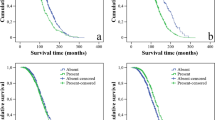Summary.
Objective:
To assess the impact of coexisting Alzheimer (AD) pathology on the natural history of Parkinson's disease (PD).
Background:
AD changes are frequently present in brains of demented PD patients. Assessing the relative contribution of AD pathology to the natural history of PD is difficult and the impact of both AD and cortical Lewy body (LB) pathologies on cognitive dysfunction is still under discussion. From clinical experience, dementia in PD patients, mainly related to AD pathology, is associated with a poor outcome, but the impact of AD pathology on the natural history of PD has not been studied systematically.
Material and methods:
In 200 consecutive autopsy cases of PD (sex (m/f) ratio 1 : 1.1), age at death 58–98 (mean 77.0 ± 9.5) years, from a specialized Austrian brain bank, retrospectively assessed major initial clinical symptoms (tremor, akinesia), moderate/severe dementia, and duration of illness were correlated with associated AD pathologies using CERAD, Braak and NIA-Reagan criteria. Mann-Whitney U-test, Cox-regression were used for statistical analysis.
Results:
While gender had no influence on the clinical motor symptoms and outcome, tremor dominant type had a significantly better outcome than akinetic forms (p = 0.022), even after adjustment with age at onset and associated AD pathology (CERAD and Braak criteria). Patients with late onset showed significantly shorter duration of illness irrespective of dementia. Moderate to severe dementia, reported in 33% of the sample, was significantly correlated with AD pathology (all 3 criteria) that showed significantly negative correlation with survival: between CERAD 0-A vs. B and C there was a significant difference of odd ratios (p < 0.001), as was between Braak stages 0–2, 3–4.5, and 5, but not between Braak stages 3–4 and 5.
Conclusions:
The present data confirm previous studies suggesting better outcome of tremor-dominant than akinetic-rigid type of PD, significantly worse outcome in PD with late onset and dementia that is significantly correlated with coexistent neuritic Alzheimer pathology, particularly when using the CERAD and NIA-R criteria for the diagnosis of AD. Further studies are needed to elucidate the relative impact of cortical LB and AD pathologies on the natural history of PD.
Similar content being viewed by others
Author information
Authors and Affiliations
Additional information
Received February 9, 2001; accepted September 10, 2001
Rights and permissions
About this article
Cite this article
Jellinger, K., Seppi, K., Wenning, G. et al. Impact of coexistent Alzheimer pathology on the natural history of Parkinson's disease. J Neural Transm 109, 329–339 (2002). https://doi.org/10.1007/s007020200027
Issue Date:
DOI: https://doi.org/10.1007/s007020200027




